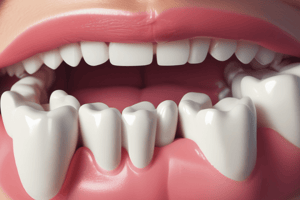Podcast
Questions and Answers
What is the primary challenge associated with dentin adhesion in restorative dentistry?
What is the primary challenge associated with dentin adhesion in restorative dentistry?
- High moisture content of the dentin
- Presence of the smear layer (correct)
- Inconsistent depth of caries
- Low surface area of the dentin
Which acid etching technique is primarily used to prepare the enamel surface for bonding?
Which acid etching technique is primarily used to prepare the enamel surface for bonding?
- Hydrochloric acid etching
- Citric acid etching
- Phosphoric acid etching (correct)
- Nitric acid etching
What property of bonding agents is essential for achieving effective adhesion to tooth structures?
What property of bonding agents is essential for achieving effective adhesion to tooth structures?
- Low viscosity
- High surface tension
- Low contact angle (correct)
- High opacity
What measuring method is primarily used to evaluate the bond strength of a dental adhesive?
What measuring method is primarily used to evaluate the bond strength of a dental adhesive?
In the context of dentin bonding, what is the primary purpose of creating resin tags?
In the context of dentin bonding, what is the primary purpose of creating resin tags?
Which component of the tooth structure is primarily affected by the adsorption bonding mechanism?
Which component of the tooth structure is primarily affected by the adsorption bonding mechanism?
What is a key characteristic of an effective adhesive in dental applications?
What is a key characteristic of an effective adhesive in dental applications?
What factor can significantly influence the bond quality between the adhesive and the tooth surface?
What factor can significantly influence the bond quality between the adhesive and the tooth surface?
Why is the conservation of tooth structure emphasized in modern restorative dentistry?
Why is the conservation of tooth structure emphasized in modern restorative dentistry?
What condition must be met to ensure effective bonding to a tooth substrate?
What condition must be met to ensure effective bonding to a tooth substrate?
What is the primary issue with bonding to dentin compared to enamel?
What is the primary issue with bonding to dentin compared to enamel?
Which of the following statements is true regarding acid etching techniques?
Which of the following statements is true regarding acid etching techniques?
What characteristic of bonding agents allows them to effectively bond to etched enamel?
What characteristic of bonding agents allows them to effectively bond to etched enamel?
How is bond strength between composite resins and etched enamel typically quantified?
How is bond strength between composite resins and etched enamel typically quantified?
What is the purpose of rinsing the enamel surface after acid etching?
What is the purpose of rinsing the enamel surface after acid etching?
What is the primary component of dentin that differs from the mineral structure of enamel?
What is the primary component of dentin that differs from the mineral structure of enamel?
Which phenomenon occurs when bonding agents polymerize within dentin?
Which phenomenon occurs when bonding agents polymerize within dentin?
What is one notable attribute of gel etchants compared to liquid etchants?
What is one notable attribute of gel etchants compared to liquid etchants?
What occurs during etching that enhances enamel bonding?
What occurs during etching that enhances enamel bonding?
Why is the removal of the smear layer particularly crucial in dentin bonding?
Why is the removal of the smear layer particularly crucial in dentin bonding?
Flashcards are hidden until you start studying
Study Notes
Enamel Bonding
- Acid etch technique was introduced in 1955 by Buonocore for resin adhesion to enamel.
- Acid etching transforms smooth enamel into an irregular surface with micro-pores, increasing the surface free energy.
- Preferred acid concentration: 37% phosphoric acid
- Etching time: 15 seconds
- Rinsing time: Double the etching time with air/water spray
- Optimum acid concentration and etching time produce mono-calcium phosphate monohydrate precipitate, easily rinsable.
- Available acid etch forms: Liquid or gel, gel preferred for easier placement.
- Gel acid placement: Done using syringe, convenient and precise.
Bonding Agents
- Bonding agents flow into enamel microporosities, forming 'resin tags' that lock them in.
- Bond strength of composite resins to etched enamel: 20-50 MPa
- Advantages of strong bonding:
- Adequate retention for various procedures
- Prevents leakage around enamel margins of restorations
Challenges in Dentin Bonding
- Dentin's chemical composition:
- Lower mineral content than enamel
- High water and organic material proportion
- Type I Collagen is the primary organic content
Dentin Bonding Mechanisms
- Hybrid layer formation: Adhesive monomers penetrate collagen fibers exposed by acid etching.
- Resin tags: Adhesive monomers penetrate dentinal tubules.
Studying That Suits You
Use AI to generate personalized quizzes and flashcards to suit your learning preferences.




